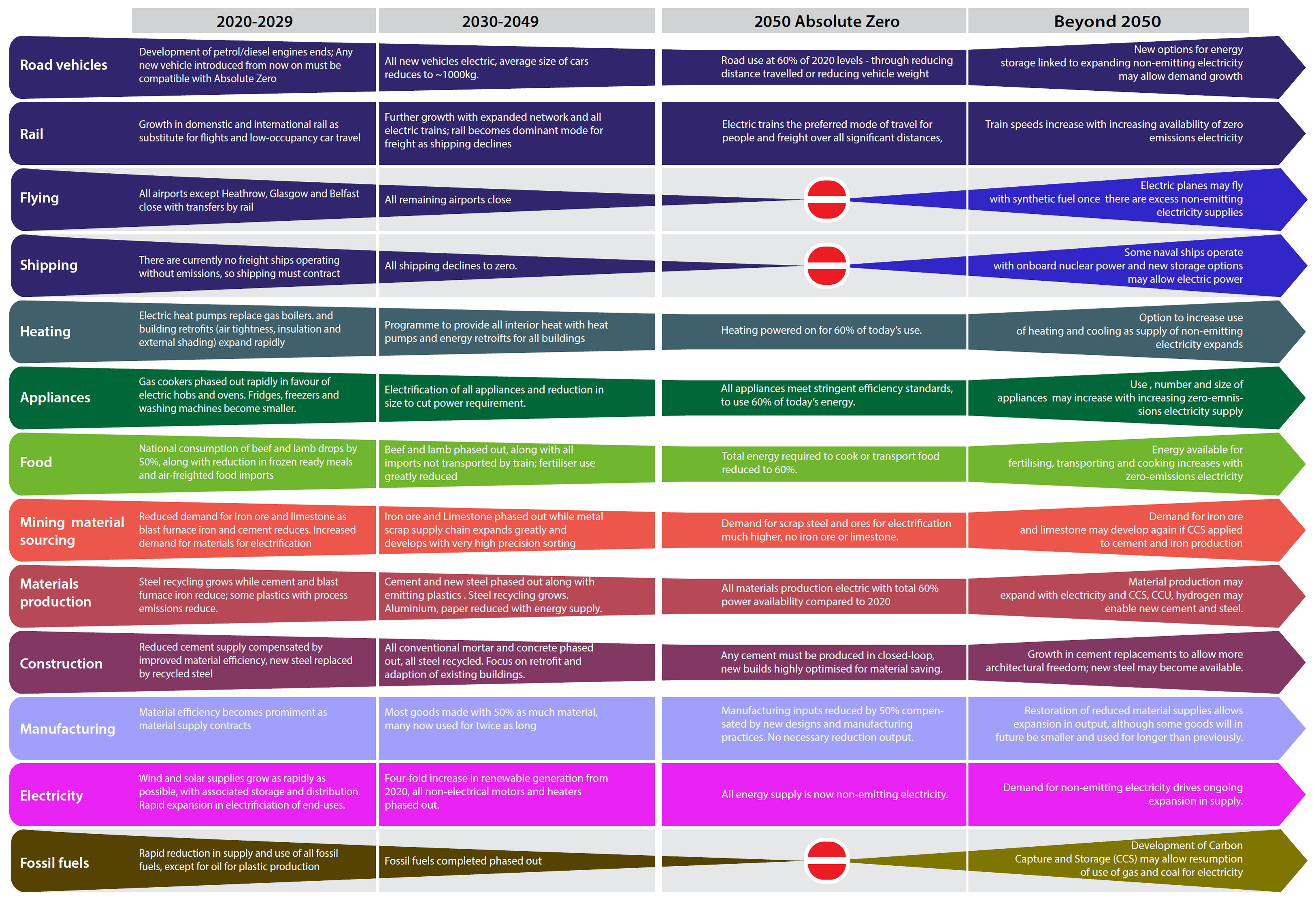
Source: AbsoluteZero [1]
Here it is the complete transformation program of the world, into an ULTRACAPITALIST hell and a GREEN nightmare:
- They cannot implement the ULTRACAPITALIST component without imposing a World Regime and abolishing democracy;
- They cannot implement the GREEN component without exterminating billions of people and depopulating the Earth;
All clear now?
* * * * * *
Road vehicles
- 2020-2029: Development of petrol/diesel engines ends; any new vehicle introduced from now on must be compatible with Absolute Zero
- 2030-2049: All new vehicles electric, average size of cars reduces to ~1000kg
- 2050 AbsoluteZero: Road use at 60% of 2020 levels – through reducing distance traveled or reducing vehicle weight
- Beyond 2050: New options for energy storage linked to expanding non-emitting electricity may allow demand growth
Rail
- 2020-2029: Growth in domestic and international rail as substitute for flights and low-occupancy car travel
- 2030-2049: Further growth with expanded network and all electric trains; rail becomes dominant mode for freight as shipping declines
- 2050 AbsoluteZero: Electric trains the preferred mode of travel for people and freight over all significant distances
- Beyond 2050: Train speeds increase with increasing availability of zero emissions electricity
Flying
- 2020-2029: All airports except Heathrow, Glasgow and Belfast close with transfers by rail
- 2030-2049: All remaining airports close
- 2050 AbsoluteZero: ⛔️ Stop
- Beyond 2050: Electric planes may fly with synthetic fuel once there are excess non-emitting electricity supplies
Shipping
- 2020-2029: There are currently no freight ships operating without emissions, so shipping must contract
- 2030-2049: All shipping declines to zero
- 2050 AbsoluteZero: ⛔️ Stop
- Beyond 2050: Some naval ships operate with onboard nuclear power and new storage options may allow electric power
Heating
- 2020-2029: Electric heat pumps replace gas boilers and building retrofits (air tightness, insulation and external shading) expand rapidly
- 2030-2049: Program to provide all interior heat with heat pumps and energy retrofits for all buildings
- 2050 AbsoluteZero: Heating powered on for 60% of today’s use
- Beyond 2050: Option to increase use of heating and cooling as supply of non-emitting electricity expands
Appliances
- 2020-2029: Gas cookers phased out rapidly in favor of electric hobs and ovens; fridges, freezers and washing machines become smaller
- 2030-2049: Electrification of all appliances and reduction in size to cut power requirement
- 2050 AbsoluteZero: All appliances meet stringent efficiency standards, to use 60% of today’s energy
- Beyond 2050: Use, number and size of appliances may increase with increasing zero-emissions electricity supply
Food
- 2020-2029: National consumption of beef and lamb drops by 50%, along with reduction in frozen ready meals and air-freighted food imports
- 2030-2049: Beef and lamb phased out, along with all imports not transported by train; fertilizer use greatly reduced
- 2050 AbsoluteZero: Total energy required to cook or transport food reduced to 60%
- Beyond 2050: Energy available for fertilizing, transporting and cooking increases with zero-emissions electricity
Mining material sourcing
- 2020-2029: Reduced demand for iron ore and limestone as blast furnace iron and cement reduces; increased demand for materials for electrification
- 2030-2049: Iron ore and Limestone phased out while metal scrap supply chain expands greatly and develops with very high precision sorting
- 2050 AbsoluteZero: Demand for scrap steel and ores for electrification much higher, no iron ore or limestone
- Beyond 2050: Demand for iron ore and limestone may develop again if CCS (carbon capture and storage) applied to iron and cement production
Materials production
- 2020-2029: Steel recycling grows while blast furnace iron and cement reduce; some plastics with process emissions reduce
- 2030-2049: Cement and new steel phased out along with emitting plastics; steel recycling grows; aluminum, paper reduced with energy supply
- 2050 AbsoluteZero: All materials production electric with total 60% power availability compared to 2020
- Beyond 2050: Material production may expand with electricity and CCS (carbon capture and storage), CCU (captured CO2 utilization), hydrogen may enable new cement and steel
Construction
- 2020-2029: Reduced cement supply compensated by improved material efficiency, new steel replaced by recycled steel
- 2030-2049: All conventional mortar and concrete phased out, all steel recycled; focus on retrofit and adaption of existing buildings
- 2050 AbsoluteZero: Any cement must be produced in closed-loop, new builds highly optimized for material saving
- Beyond 2050: Growth in cement replacements to allow more architectural freedom; new steel may become available
Manufacturing
- 2020-2029: Material efficiency becomes prominent as material supply contracts
- 2030-2049: Most goods made with 50% as much material, many now used for twice as long
- 2050 AbsoluteZero: Manufacturing inputs reduced by 50% compensated by new designs and manufacturing practices; no necessary reduction output
- Beyond 2050: Restoration of reduced material supplies allows expansion in output, although some goods will in future be smaller and used for longer than previously
Electricity
- 2020-2029: Wind and solar supplies grow as rapidly as possible, with associated storage and distribution; rapid expansion in electrificiation of end-uses
- 2030-2049: Four-fold increase in renewable generation from 2020, all non-electrical motors and heaters phased out
- 2050 AbsoluteZero: All energy supply is now non-emitting electricity
- Beyond 2050: Demand for non-emitting electricity drives ongoing expansion in supply
Fossil fuels
- 2020-2029: Rapid reduction in supply and use of all fossil fuels, except for oil for plastic production
- 2030-2049: Fossil fuels completed phased out
- 2050 AbsoluteZero: ⛔️ Stop
- Beyond 2050: Development of CCS (carbon capture and storage) may allow resumption of use of gas and coal for electricity


